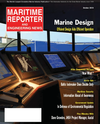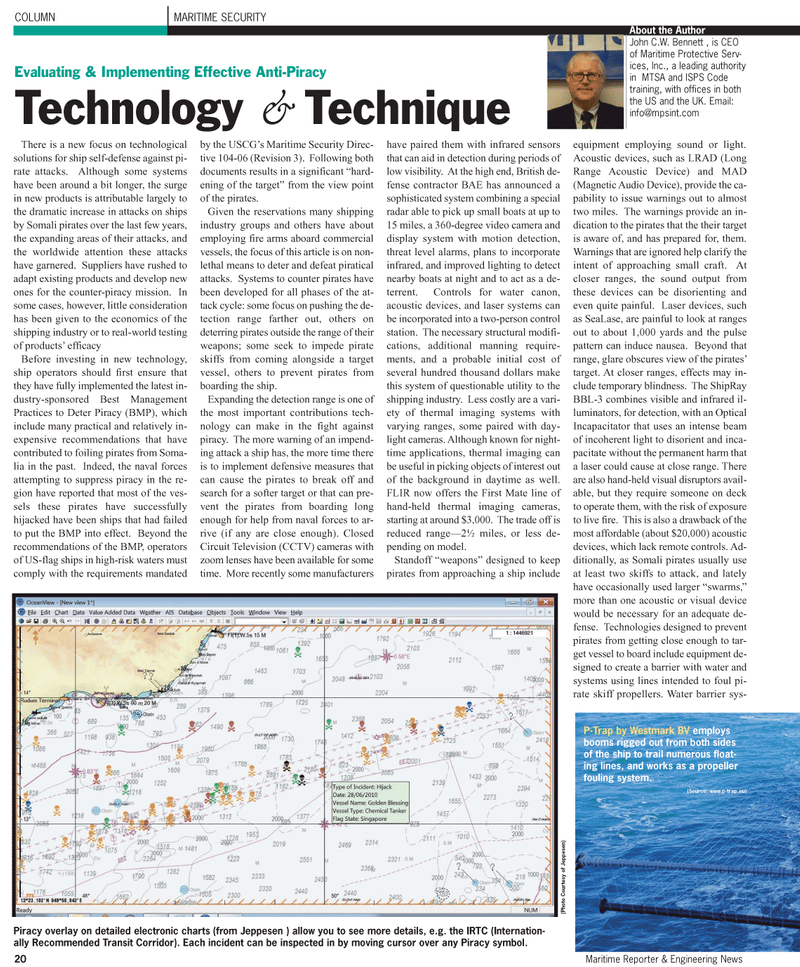
Page 20: of Maritime Reporter Magazine (October 2010)
Marine Design Annual
Read this page in Pdf, Flash or Html5 edition of October 2010 Maritime Reporter Magazine
20 Maritime Reporter & Engineering News
There is a new focus on technological solutions for ship self-defense against pi- rate attacks. Although some systems have been around a bit longer, the surge in new products is attributable largely to the dramatic increase in attacks on ships by Somali pirates over the last few years, the expanding areas of their attacks, and the worldwide attention these attacks have garnered. Suppliers have rushed to adapt existing products and develop new ones for the counter-piracy mission. In some cases, however, little consideration has been given to the economics of the shipping industry or to real-world testing of products’ efficacy
Before investing in new technology, ship operators should first ensure that they have fully implemented the latest in- dustry-sponsored Best Management
Practices to Deter Piracy (BMP), which include many practical and relatively in- expensive recommendations that have contributed to foiling pirates from Soma- lia in the past. Indeed, the naval forces attempting to suppress piracy in the re- gion have reported that most of the ves- sels these pirates have successfully hijacked have been ships that had failed to put the BMP into effect. Beyond the recommendations of the BMP, operators of US-flag ships in high-risk waters must comply with the requirements mandated by the USCG’s Maritime Security Direc- tive 104-06 (Revision 3). Following both documents results in a significant “hard- ening of the target” from the view point of the pirates.
Given the reservations many shipping industry groups and others have about employing fire arms aboard commercial vessels, the focus of this article is on non- lethal means to deter and defeat piratical attacks. Systems to counter pirates have been developed for all phases of the at- tack cycle: some focus on pushing the de- tection range farther out, others on deterring pirates outside the range of their weapons; some seek to impede pirate skiffs from coming alongside a target vessel, others to prevent pirates from boarding the ship.
Expanding the detection range is one of the most important contributions tech- nology can make in the fight against piracy. The more warning of an impend- ing attack a ship has, the more time there is to implement defensive measures that can cause the pirates to break off and search for a softer target or that can pre- vent the pirates from boarding long enough for help from naval forces to ar- rive (if any are close enough). Closed
Circuit Television (CCTV) cameras with zoom lenses have been available for some time. More recently some manufacturers have paired them with infrared sensors that can aid in detection during periods of low visibility. At the high end, British de- fense contractor BAE has announced a sophisticated system combining a special radar able to pick up small boats at up to 15 miles, a 360-degree video camera and display system with motion detection, threat level alarms, plans to incorporate infrared, and improved lighting to detect nearby boats at night and to act as a de- terrent. Controls for water canon, acoustic devices, and laser systems can be incorporated into a two-person control station. The necessary structural modifi- cations, additional manning require- ments, and a probable initial cost of several hundred thousand dollars make this system of questionable utility to the shipping industry. Less costly are a vari- ety of thermal imaging systems with varying ranges, some paired with day- light cameras. Although known for night- time applications, thermal imaging can be useful in picking objects of interest out of the background in daytime as well.
FLIR now offers the First Mate line of hand-held thermal imaging cameras, starting at around $3,000. The trade off is reduced range—2½ miles, or less de- pending on model.
Standoff “weapons” designed to keep pirates from approaching a ship include equipment employing sound or light.
Acoustic devices, such as LRAD (Long
Range Acoustic Device) and MAD (Magnetic Audio Device), provide the ca- pability to issue warnings out to almost two miles. The warnings provide an in- dication to the pirates that the their target is aware of, and has prepared for, them.
Warnings that are ignored help clarify the intent of approaching small craft. At closer ranges, the sound output from these devices can be disorienting and even quite painful. Laser devices, such as SeaLase, are painful to look at ranges out to about 1,000 yards and the pulse pattern can induce nausea. Beyond that range, glare obscures view of the pirates’ target. At closer ranges, effects may in- clude temporary blindness. The ShipRay
BBL-3 combines visible and infrared il- luminators, for detection, with an Optical
Incapacitator that uses an intense beam of incoherent light to disorient and inca- pacitate without the permanent harm that a laser could cause at close range. There are also hand-held visual disruptors avail- able, but they require someone on deck to operate them, with the risk of exposure to live fire. This is also a drawback of the most affordable (about $20,000) acoustic devices, which lack remote controls. Ad- ditionally, as Somali pirates usually use at least two skiffs to attack, and lately have occasionally used larger “swarms,” more than one acoustic or visual device would be necessary for an adequate de- fense. Technologies designed to prevent pirates from getting close enough to tar- get vessel to board include equipment de- signed to create a barrier with water and systems using lines intended to foul pi- rate skiff propellers. Water barrier sys-
COLUMN MARITIME SECURITY
Evaluating & Implementing Effective Anti-Piracy
Technology & Technique
About the Author
John C.W. Bennett , is CEO of Maritime Protective Serv- ices, Inc., a leading authority in MTSA and ISPS Code training, with offices in both the US and the UK. Email: [email protected]
Piracy overlay on detailed electronic charts (from Jeppesen ) allow you to see more details, e.g. the IRTC (Internation- ally Recommended Transit Corridor). Each incident can be inspected in by moving cursor over any Piracy symbol. (Photo Cour tesy of Jeppesen)
P-Trap by Westmark BV employs booms rigged out from both sides of the ship to trail numerous float- ing lines, and works as a propeller fouling system. (Source: www.p-trap.eu)

 19
19

 21
21
